When I first started watching cricket, I remember being fascinated by the way bowlers like Glenn McGrath could make the ball seam in different directions once it had hit the pitch. I knew McGrath was an elite bowler, but when he was on form it seemed like he could make the ball do whatever he wanted it to. There was a spell he bowled at Lords against England in 2005 where he took five wickets in the first innings, and those wickets came primarily because of how much seam movement he was able to get on the ball. After seeing him destroy England’s batting line up that day, I wanted to learn how to get the ball to seam just like he did. If you’re also wanting to know how to do it, then you’re in the right place!
In this post I’m going to share everything that I’ve learned over the years about seam movement and how you can achieve it. We’ll go through some technical tips and I’ll also share some simple little tricks and drills you can use to help groove your bowling technique in a way that will help you get the ball to seam more regularly!
First though, let’s take a quick look at what I mean when I say ‘seam movement’…
What Is Seam Movement?
Seam movement is a phenomenon that occurs occasionally when the cricket ball makes contact with the pitch. It causes the cricket ball to deviate from its intended path, and as a result the ball will usually either seam in towards the batsman, or seam away from them.
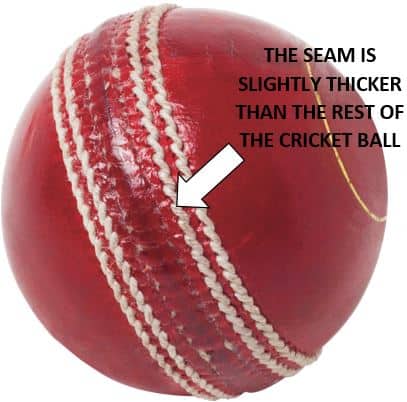
Seam movement occurs because the seam on a cricket ball is slightly raised. This means that it is slightly thicker than the rest of the ball. You can see the raised seam in my picture above! Because of this design, if the seam makes contact with the pitch while it is slightly tilted, it can cause the ball to deviate in a different direction. The diagram below should explain what I mean by this! Fast bowlers should aim to get the seam wobbling slightly as the ball travels through the air so that there is more chance of the seam making contact with the pitch in this way.
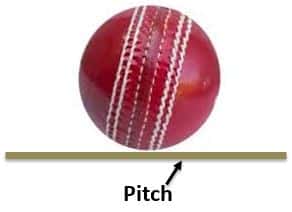
Seam movement is incredibly hard for batsmen to deal with because they have no idea when it is going to happen, and when it does happen, they don’t have enough time to react to it. If a fast bowler is bowling at around 80-85mph and the ball lands 4-5 metres in front of the batsman, the batsman will have about 2 tenths of a second to react if the ball seams in towards them or away from them. It’s literally impossible to do accurately!
How Do Bowlers Get The Ball To Seam?
So, how do bowlers make the ball deviate when it hits the pitch? The basic answer is that it requires a large amount of luck! No bowler is 100% sure that they will get seam movement when the ball leaves their hand. It totally depends on how the ball lands and whether it makes a specific type of contact with the pitch. Certain pitches make the ball more prone to seam movement too! This is why seam movement is referred to as a ‘natural variation’. It is heavily influenced by factors outside of the bowlers control such as the pitch conditions and how the seam interacts with the surface.
Although there is a large natural component to seam movement, there are many things you can do as a fast bowler which will help you to achieve it more often. In the rest of this post I will be sharing some tips with you that will help you do that. These tips will also help to make sure that when you do achieve seam movement, it will be more likely to cause the batsman problems and take wickets!
Here are my tips that will help you get the ball to seam:
- Use the wobble seam delivery
- Ensure you have a good wrist position when you release the ball
- Target vulnerable areas of the pitch
- Bowl with the new ball
- Get the ball in dangerous areas and let natural variation do the work
- Try bowling cross seam deliveries
Now let’s go through each tip individually so I can explain exactly how they can help you!
Use the Wobble Seam Delivery
The wobble seam delivery is a type of delivery that seems to have become more popular in recent years. I watch a lot of English cricket, and I know that hugely successful test match bowlers like Jimmy Anderson and Stuart Broad have worked hard to perfect this delivery and add it to their repertoire.
So, what is the wobble seam delivery? Basically, it is a ball that is bowled with the seam up. However, instead of the seam being fully upright as the ball moves through the air, the seam will ‘wobble’ slightly from side to side.
As I already mentioned above, getting the seam to wobble as the ball moves through the air means there is a higher chance that the corner of the seam will make contact with the pitch. In other words, the part of the ball that hits the pitch will be a 50/50 split between the seam and the leather. Landing the ball at this angle to the pitch means there will be a higher chance that the ball will shoot off in the direction that the seam is tilted.
If you would like to try bowling the wobble seam delivery, follow these steps:
- Hold the ball in the conventional fast bowling grip, with your index and middle finger running parallel with the seam.
- Now spread your index and middle finger a little bit wider. The photo on the right below should show you this change! Both fingers should now be resting on the leather part of the ball. Take care not to spread your fingers too wide – this only needs to be a slight adjustment!
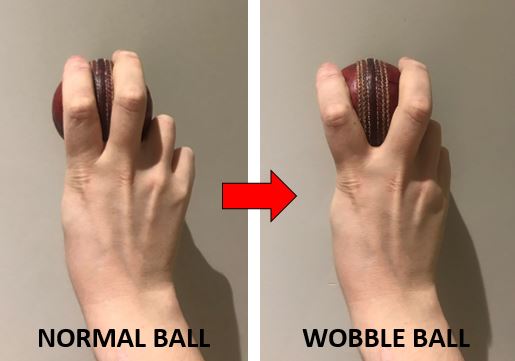
- Go through your run up and bowling action as usual
- As you get into your delivery stride and prepare to release the ball, keep your wrist locked. Instead of trying to ‘push’ the ball towards the batsman with the tips of your index/middle fingers as it leaves your hand, try to just let it roll off the fingers.
To judge whether you’re getting the seam to wobble appropriately, you can do any of the following:
- Get a partner to stand behind you and watch the ball as it travels through the air
- Set up a camera to film the flight of the ball and review the footage
- Use a training ball with a red side and a white side – you can find a great one here on amazon! This contrast in colours make it easy to see if you’re getting the ball to wobble or not.
This type of delivery takes a while to develop, but if you can devote enough time to practicing it it will become a very useful tool. Especially when you’re bowling in conditions that don’t offer a lot of movement through the air!
Ensure You Have a Good Wrist Position When You Release the Ball
Getting your wrist and your hand in the correct position as you release the ball can help you to get the ball to move off the pitch. Ideally, at the point of release your wrist should be locked and your arm should be in a linear position, similar to the picture on the left below.
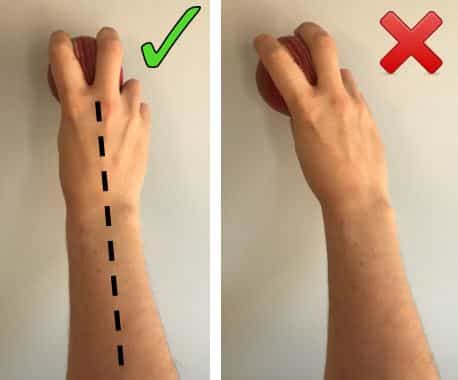
Having your wrist and your hand in this centralised position when the ball leaves your hand helps to keep your wrist directly behind the ball, which makes the line of the delivery easier to control. It also helps to keep the seam upright as the ball travels towards the batsman. As we’ve already discussed, keeping the seam upright in this way is one of the vital things you need to do if you’re going to have a good chance of achieving seam movement.
If your wrist is loose when you bowl it means your wrist will not be fully behind the ball, making it easier to lose control of the line and seam position during flight. This can lead to the ball coming out with a scrambled seam, which makes seam movement harder to achieve.
If you want to train yourself to keep your arm in this linear position and get your wrist behind the ball as you release it, I’d recommend trying the following things:
Lock Your Arm As You Approach The Crease
As you run into bowl, instead of letting your arms flail around, try locking your bowling arm tightly at the side of your body in the position that you want to release the ball from. Basically, your arm should be in the position I showed earlier, with your wrist locked nice and centrally. Keep your arm in this position as you approach the crease and then deliver the ball as normal.
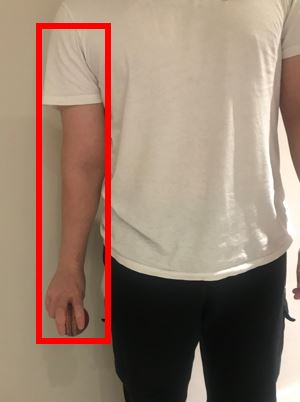
Keeping your arm locked in position like this helps you to become comfortable with the central position the wrist needs to be in during the release phase of the action!
Use Visualisation
When I was trying to improve my wrist position, I would imagine that there was a metal rod running through my arm from my elbow to the tip of my middle finger. Thoughts like these really helped me to keep my wrist locked and to stop my hand drifting to the left and right as I delivered the ball.
Perform A Simple Wrist Position Drill
There’s a remarkably simple little drill you can use in your spare time to practice your wrist position. If you fancy giving it a try, follow these steps:
- Hold a cricket ball in your hand with the normal fast bowling grip. It should look like the grip I’m demonstrating below!
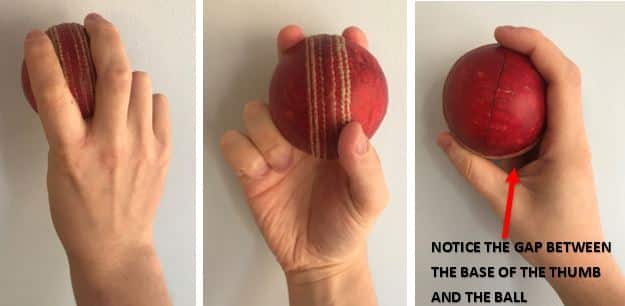
- Once you have the ball in the right grip, rotate your hand so that the palm of your hand is pointing upwards towards the sky.
- Now, bring your arm upwards and flex your wrist slightly to throw the ball up in the air.
- As the ball leaves your hand, you should make sure that your wrist is in the stable, central position that we’ve been discussing. Also, focus on letting the ball roll off your index finger and your middle finger evenly, allowing them to push the ball up in to the air. This recreates the movement that occurs when your index and middle fingers propel the ball towards the batsman when you’re bowling.
- Watch the ball as it goes up in the air, and pay close attention to how it is rotating. If the ball rotates with the seam wobbling rapidly from side to side, your wrist wasn’t in the most stable position. If the ball rotates perfectly along the axis of the seam, without much wobble, then you know your wrist is fully behind the ball!
As I mentioned earlier, I’d recommend buying yourself a training ball with sides that have two different colours and practicing with that. This will help you to see if the ball is leaving your hand with a good seam position, or if you need to adjust your approach. You can also get someone to watch you bowl or film yourself! Whatever works for you!
Don’t be disheartened if you don’t get your wrist and seam position spot on straight away. This is something that often requires a lot of work and effort, even for professionals! If you’re committed to improving your craft then you should steadily see your ability to bowl with good seam position improve over time.
Target Vulnerable Areas of the Pitch
As we’ve already discussed, the condition of the pitch is one of the main factors that contribute towards seam movement. If the pitch is incredibly dry and has cracks appearing in it, or even if it’s damp and has lots of moisture in the surface, this can be something that the bowler can take advantage of.
During test matches in places like Australia or India where there is lots of hot weather, pitches can become cracked easily. These cracks become a massive target for the bowler to hit, and a huge danger for the batsman. If the bowler can get the ball to land on the seam on one of these cracks it can cause the ball to bounce in dramatically different directions. It could also cause the ball to bounce more or to less than expected. As we’ve discussed, getting this type of movement on the ball is almost impossible for the batsman to deal with!
Let’s imagine you’ve successfully targeted a crack in the pitch and caused the ball to violently seam back in towards the batsman. After the batsman has seen this occur, it’s highly likely that they’ll be incredibly cautious when playing at any other deliveries that bounce in a similar area. If your next delivery lands close to where the first one did, the batsman may not move their feet or their bat towards the ball as confidently, and this can lead to them playing false shots!
To sum this section up, targeting dangerous areas of the pitch like this can lead to dismissals, and it can also harm the batsman’s confidence in a big way. This makes it a hugely effective tactic when it comes to seam bowling!
Bowl with the New Ball
There are plenty of differences between a brand new cricket ball that has never been used, and an older ball which has been bowled with for somewhere in excess of 20 overs. The older ball will have taken lots of punishment due to being propelled into the pitch repeatedly and being struck by the bat. It also may have taken on plenty of moisture if the outfield is wet! All of this damage will mean that the ball will have softened and gone duller in colour, and the seam will have become a lot less pronounced. Due to the softness of the ball and of the seam, and the fact that the seam isn’t as raised compared to the rest of the ball, it is very difficult to achieve seam movement.
Contrast this with a brand new ball. This ball will be shiny, rock hard, and the seam will be a lot thicker and more pronounced. This means that when the ball makes contact with the pitch, the seam is more likely to influence the ball to bounce in an irregular direction!
To put it simply, the best time to bowl if you want to get plenty of seam movement is as an opening bowler! If you can convince your captain to let you open the innings then this will definitely give you more chance of getting some movement off the pitch.
Get the Ball in Dangerous Areas & Let Natural Variation do the Work
If you’ve been following the game of cricket for a while, you may have heard of a legendary fast bowler called Michael Holding. He is one of the most fearsome bowlers of all time, and took plenty of wickets in a truly dominant West Indies team a few decades ago. He also commentates a lot on Sky Sports!
He regularly gets asked what techniques he used to get seam movement on the ball, and he nearly always tells people that seam movement wasn’t something he really thought about when bowling. What he did think about was getting his wrist directly behind the ball and ensuring that he achieved a good seam position, as well as bowling the ball in areas that would make seam movement more dangerous. Basically, he just bowled the ball on a challenging line and length, and if he achieved any seam movement as a result of natural variation, the delivery would instantly become a potential wicket taker.
If you can’t bowl a consistent line and length, then any deliveries where you do achieve seam movement will probably be less effective. For example, if you bowl the ball well outside off stump, it will be very hard for the batsman to reach. Therefore, it won’t matter as much if the ball moves off the seam! The batsman can simply choose to leave this delivery alone, confident in the fact that the ball will not be threatening the stumps or the pads.
Now, imagine a delivery that is on a good length and is just fractionally outside the line of off stump. This is a ball that the batsman will probably feel like they have to play a shot at, because they cannot be sure that it’s going to miss the stumps. Once you have landed the ball in this area and forced the batsman into a shot, any seam movement that occurs once the ball hits the pitch could easily get you a wicket. If the ball seams away from the batsman, it could hit the outside edge of the bat and travel through to the keeper. If it seams in towards them, it could strike them on the pad or hit the stumps. Bowling the ball consistently in challenging areas like this means that when the ball does seam as a result of natural variation, it becomes very dangerous.
Anyone that is aiming to be able to bowl consistent line and length is going to have to work very hard in practice. If you want some ideas of how to practice, including several drills for improving your accuracy, then you’re in luck – I’ve written a post dedicated to it which you can read by clicking here!
Try Bowling Cross Seam Deliveries
Bowling cross seam deliveries can help you to achieve a different type of seam movement than a normal delivery. This makes it an incredibly effective variation! It’s a type of delivery that many professionals use when they want to make the ball behave a little differently when it hits the pitch.
At this point you may be wondering, what’s the difference between the normal fast bowling delivery and the cross seam delivery? Well, the main difference is the way you grip the ball. The normal fast bowling grip requires you to place the seam vertically so it runs parallel with your fingers. The cross seam delivery features the seam running the opposite way, across the fingers. The difference between the grips for the two deliveries is shown in the photos below.
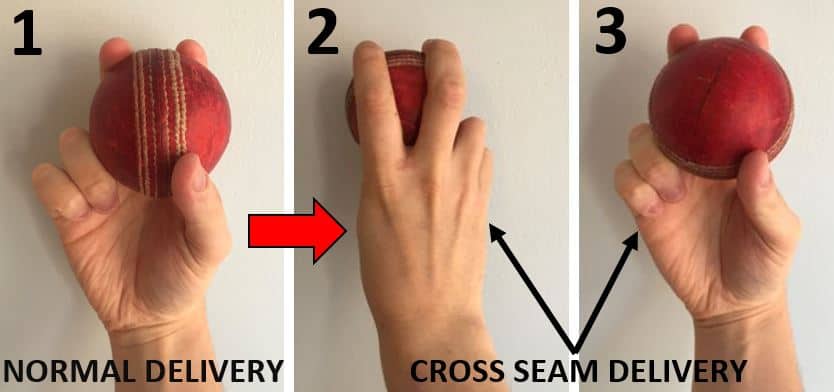
The difference in grip means that as the two deliveries travel through the air, the seam rotates in a different way. The normal fat bowling delivery will travel through the air with the seam still in its original vertical position, and the ball will be rotating along that axis. The cross seam delivery will be rotating in the opposite direction to the seam, and this causes the seam to look ‘scrambled’ as the ball travels through the air. The diagram below will help to explain the differences in the way the two deliveries rotate.
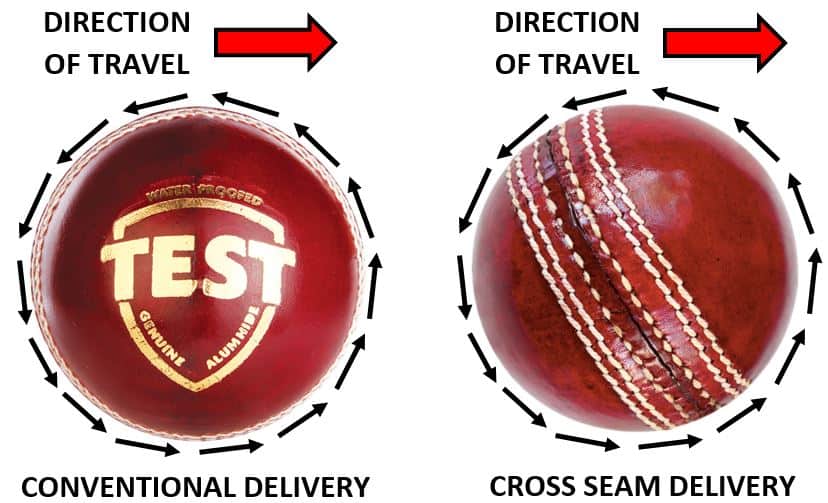
Because of the way the cross seam delivery rotates, it offers a few advantages when compared to the normal fast bowling delivery. These are as follows:
- The ball could land and get the seam stuck in the pitch as you can see in the diagram below. If the seam were to get stuck in the pitch like this then there is a good chance that the cricket ball would slow down more than usual. It’s also likely that the ball will bounce more than normal!
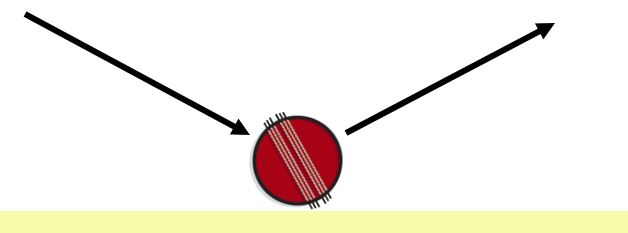
- The ball could land so that the leather part of the ball makes contact with the pitch. If this happens, then there is a good chance that the ball could skid on towards the batsman and keep low, due to the fact that the sides of the ball don’t cause as much friction when they make contact with the pitch as the seam would. Again, you can see this in the diagram below.
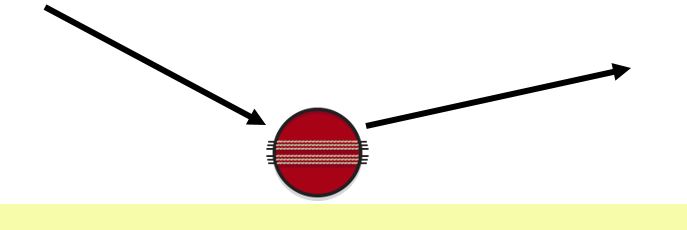
As you can see from the info above, the cross seam delivery can create slightly different variations in bounce and the speed off the pitch when compared to a normal, seam up delivery. This is one of the reasons why so many bowlers choose to use it when the pitch gets a little bit flat! Try it out for yourself in the nets and see if you can make the ball behave strangely!
Conclusion
Getting the ball to seam when it hits the pitch can look like a cricketing skill that is shrouded in mystery, but I hope I’ve managed to make it seem a little more accessible to you all today. The truth is that seam movement in large part comes down to luck. However, to give yourself the best chance of achieving seam movement, you should be following the steps I’ve laid out in this post!
If you take anything away from this post, remember that as long as you land the ball in dangerous areas and target the top of off stump, you will cause batsmen serious problems. Any seam movement that you can achieve on top of that is simply a bonus (and a frequently deadly one!)
